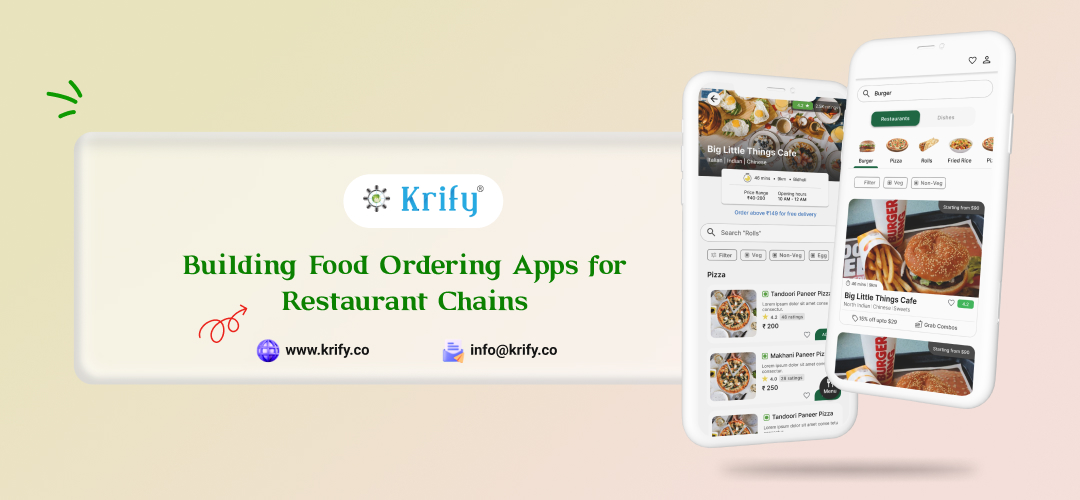In today’s digital age, food ordering apps have become a must for restaurant chains to stay competitive and meet customer expectations. Building a food ordering app for restaurant chains involves more than just providing a platform for online orders—it requires strategic planning, user-centric design, and seamless integration. By streamlining operations, enhancing the customer experience, and leveraging technology, these apps help restaurants expand their market reach and increase revenue. Let’s explore the essential features and steps to build a high-performing food ordering app tailored for restaurant chains.
Key Features of a Food Ordering App
1. User-Friendly Interface
A smooth, intuitive interface ensures customers can easily browse menus, place orders, and make payments. When customers enjoy a seamless ordering experience, they are more likely to return.
– Provide easy navigation with clear menus and categories.
– Allow users to customize orders with special requests and preferences.
– Include onboarding tutorials to guide first-time users.
2. Efficient Order Management System
The backbone of any food ordering app is an efficient order management system. It ensures that orders flow smoothly from customers to the kitchen and delivery team.
– Automate order tracking and status updates for customers.
– Allow restaurant staff to update stock levels in real time.
– Notify customers about expected delivery times and delays.
3. Multiple Payment Options
Offering flexible payment methods enhances user convenience. When customers have more payment choices, they are more likely to complete transactions.
– Integrate payment gateways for credit cards, UPI, wallets, and COD.
– Provide secure payment processing with encryption and fraud detection.
– Include the option to save payment details for faster checkouts.
4. Real-Time Delivery Tracking
Real-time tracking keeps customers informed and enhances transparency. By showing delivery progress on a live map, restaurants can improve customer satisfaction.
– Use GPS technology to provide accurate delivery tracking.
– Send push notifications about delivery status changes.
– Offer estimated delivery times for better planning.
5. Loyalty Programs and Promotions
Building customer loyalty is essential for restaurant chains. A well-implemented loyalty program encourages repeat business by offering rewards and personalized discounts.
– Track points and rewards earned through the app.
– Send exclusive offers to regular customers.
– Integrate referral programs to expand the customer base.
Steps to Build a Food Ordering App For Restaurant chains
1. Conduct Market Research
Begin by analyzing the market to identify current trends and customer preferences. Understanding the competition and your target audience helps you design a more effective app.
– Study competitors’ apps to learn about their strengths and weaknesses.
– Survey customers to understand their ordering habits and expectations.
– Identify gaps in the market where your app can add value.
2. Choose the Right Technology Stack
Selecting the right tools and frameworks is critical for the app’s performance. Ensure that the technology stack supports scalability to handle increased traffic during peak hours.
– Use native or hybrid frameworks for Android and iOS development.
– Implement cloud-based solutions to store data securely.
– Include APIs for payment gateways, delivery tracking, and CRM systems.
3. Design the User Interface (UI) and User Experience (UX)
Your app’s success depends heavily on the design of the UI and UX. A visually appealing and easy-to-use app ensures a positive user experience.
– Keep the design minimalistic and aligned with the restaurant’s brand.
– Optimize loading speeds for fast access to menus and pages.
– Make the app responsive for both smartphones and tablets.
4. Integrate with POS and Inventory Systems
Seamless integration with the restaurant’s POS and inventory systems ensures efficient operations. When orders sync with backend systems, it reduces the chances of errors and delays.
– Update stock levels automatically to avoid out-of-stock situations.
– Sync sales data with financial systems for easy accounting.
– Allow staff to manage orders through the POS terminal.
5. Test for Performance and Security
Testing ensures the app functions smoothly across devices and networks. A well-tested app reduces bugs and vulnerabilities, leading to a better user experience.
– Conduct load testing to ensure the app handles high traffic.
– Use penetration testing to identify security risks.
– Test on multiple devices and operating systems for compatibility.
Benefits of Building a Food Ordering App for Restaurant Chains
1. Increased Sales and Reach
Apps allow restaurants to reach more customers, including those who prefer ordering online.
2. Improved Customer Engagement
Loyalty programs and push notifications encourage repeat orders and engagement.
3. Streamlined Operations
Integration with POS and delivery systems simplifies restaurant management.
4. Data-Driven Insights
Analytics dashboards help restaurants monitor trends and improve services.
Conclusion
Building a food ordering app for restaurant chains requires thoughtful planning, feature-rich development, and seamless integration. From a user-friendly interface to efficient order management systems, every element contributes to customer satisfaction and business growth. By focusing on innovation and customer engagement, restaurant chains can create a powerful app that drives sales and streamlines operations. Investing in a well-designed food ordering app is not just a trend—it’s a necessity for restaurant chains aiming for long-term success in today’s competitive market.
Need Help Building Your Food Ordering App?
At Krify, we specialize in developing high-quality, customized food ordering apps that meet your unique business needs. Contact us today to build an app that keeps your restaurant chain ahead of the competition.



